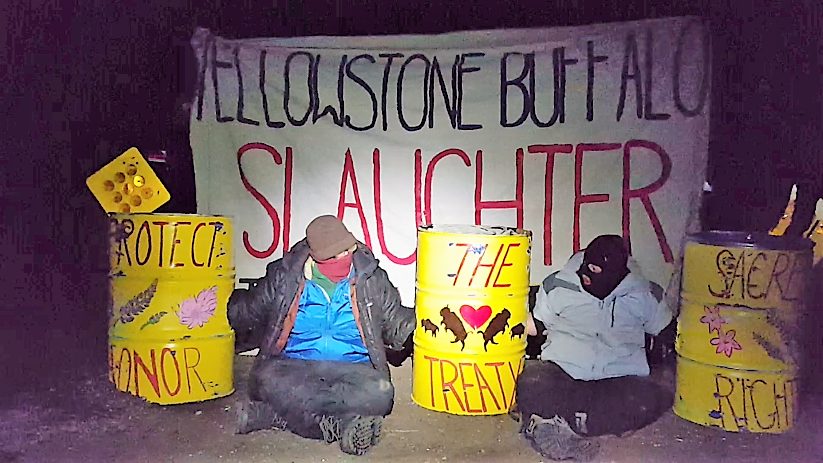
by DGR News Service | Mar 16, 2018 | Indigenous Autonomy, Obstruction & Occupation
March 16th 2018
For Immediate Release
Media Contact: Talon Brings Buffalo
406-404-9131
Stephens Creek Trap, Yellowstone National Park
March 16th 2018
Hours before dawn on Friday March 16th, two members of the Wild Buffalo Defense collective arrived at the gate of Yellowstone National Park’s Stephens Creek Buffalo capture facility. They blocked the gate with three 55 gallon drums filled with concrete, locking their arms inside the barrels. The three 1000 pound drums blocked access to the facility, preventing livestock trucks from taking the wild buffalo to slaughter. This action came in the wake of a similar event last week at the Stephens Creek Trap, where two buffalo protectors locked themselves to the hydraulic squeeze shoot using a metal pipe.
Wolf, the first individual locking down, described why he was taking the action: “My father is from Michaocan, Mexico, so I have both native and colonizer blood. Since I wasn’t raised in a native setting, this is my way to give back to the native community. I’m from Illinois — it’s called the Prairie State, and there’s less than one one-hundredth of the prairie left. It’s all strip malls and corn fields…I don’t like seeing just concrete and steel. Seeing how peaceful the buffalo are and how strong they are, they go through enough hardship in their lives in the forest and the plains and then with what Yellowstone National Park is doing to them they still carry on. They inspire me to keep going.”
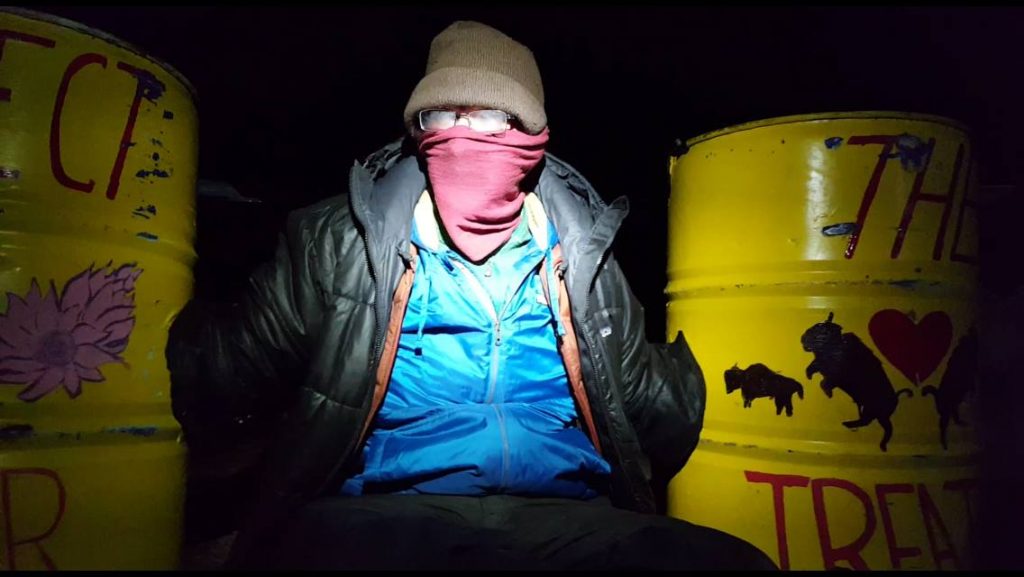
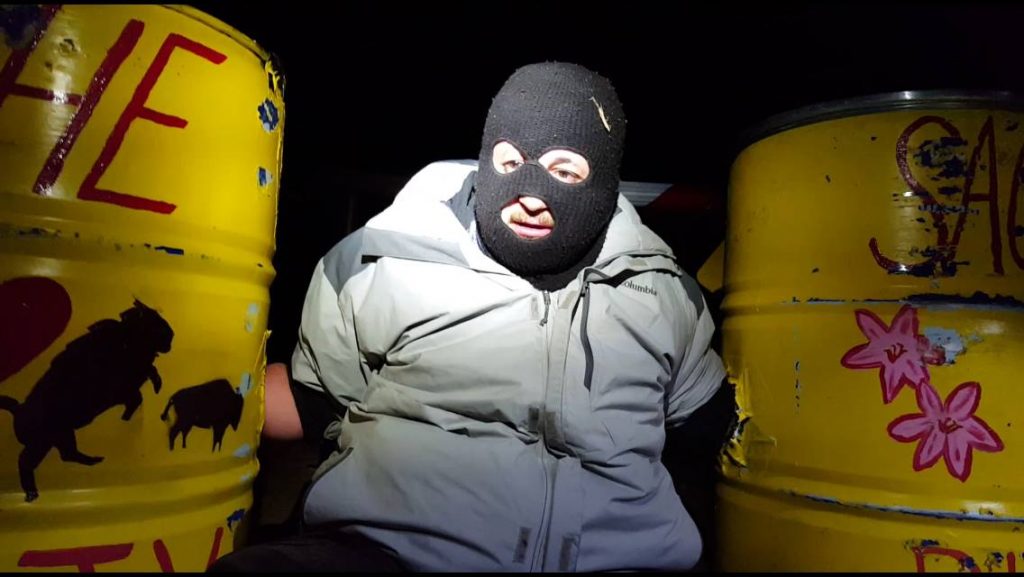
Coyote, the other individual blocking the gate, said: “I’m doing this to get a better understanding of what is really going on and to protect the buffalo and the lands that they roam. I feel like I have been lost inside…but now that I’m here I feel more combined with myself, with others, and with knowledge and understanding. Whenever I’m with the buffalo I feel like my heart runs with them. When I’m with them they already know the questions, they already know the answers, and I don’t have to respond because they already know. I think it’s a good thing for people to learn. There’s not a day in this world where you’re not able to learn something. What we’re doing is something we love to do and we only live once so we should do what we love to do and if anybody wants to come out and join and learn this experience then they should.”
The barrels were painted with two phrases, “Protect the Sacred” and “Honor the Treaties.” The words highlight the fact that Buffalo are sacred creatures to the Plains Indians. Blackfeet and Lakota prophecies say that when the wild buffalo return, the people and the earth will be healed. Yellowstone National Park currently captures and slaughters about 25% of the herd every year. If this mismanagement of the population continues, these prophecies will… [press release ends].
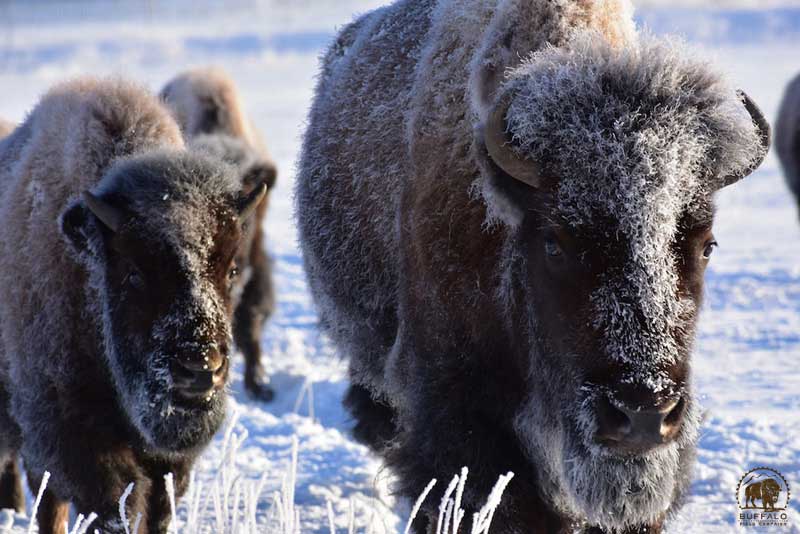
by Deep Green Resistance News Service | Mar 1, 2018 | Biodiversity & Habitat Destruction
Featured image: A single mom with seven calves who she is caring for. More than likely, only one of these calves are hers, and the rest of these babies are buffalo she adopted after their mothers were killed by hunters. BFC photo by Stephany Seay.
by Stephanie Seay / Buffalo Field Campaign
It’s just below zero as we trek through freshly fallen snow on an unusually windless early morning, in the high hills above the Gardiner Basin. Taking advantage of the calm air that won’t rock our scopes and cameras, our patrol is on the way to a lookout spot high above Yellowstone’s Stephens Creek buffalo trap. The trap is miles away. The spot we’re at is one of the few places that we can see even a far-away glimpse into the industrial size monstrosity that has entrapped more than 450 of the gentle giants in the past couple of weeks. Yellowstone initiates a massive seven-mile public closure around their trap, obviously wanting to hide the horrible things they are doing to this sacred species, our national mammal. On our way to the lookout, our footsteps squeaking through the freezing cold snow, one of our crew shouts out, “wolves!” We all stop dead in our tracks. To the south of us, we can hear them, the beautiful, haunting serenade of a wolf pack, singing blessing songs to the morning, or, more like mourning songs to the travesty unfolding before us. The wolves know. We get to the lookout spot and it’s as bad as we thought: hundreds of buffalo in the trap, huddled together, eating hay rations, trapped on death row. Four park wranglers on horseback, and a white SUV are coming into the northernmost paddock of the trap which holds approximately 60 of the country’s last wild buffalo. This paddock is the veritable end of the line before the buffalo go in even deeper, to places they will never return from.
“Genocide,” our Blackfeet brother says. We nod in agreement. The U.S. Government continues the systematic destruction of the sacred buffalo, and for the same reasons, too. Only, these days, instead of Buffalo Bill and Wild Bill Cody, they call it “management” and the killers are the so-called guys in green: Yellowstone National Park. Donning buffalo on their uniform badges, they are the very ones who are obligated to protect the buffalo — the buffalo who are the main reason this park even exists, that people even come here. These “caretakers” are facilitating all of the trapping and most of the killing. As we watch through our scopes and binoculars, eyes teary from the blistering cold, or the pain in our hearts, the wranglers go in for the attack. It’s just another day in the park. Frantic, the sixty buffalo run away from the wranglers, but the only path open to them is the dark corridor that leads into the labyrinth of the trap, towards the bull pen and the squeeze chute, towards the end of freedom and family, into the tiny holding pens where they will spend their last hours in feces and fear, before being loaded onto livestock trailers headed for the slaughter house. The mournful howling continues. The wolves know. We join in.
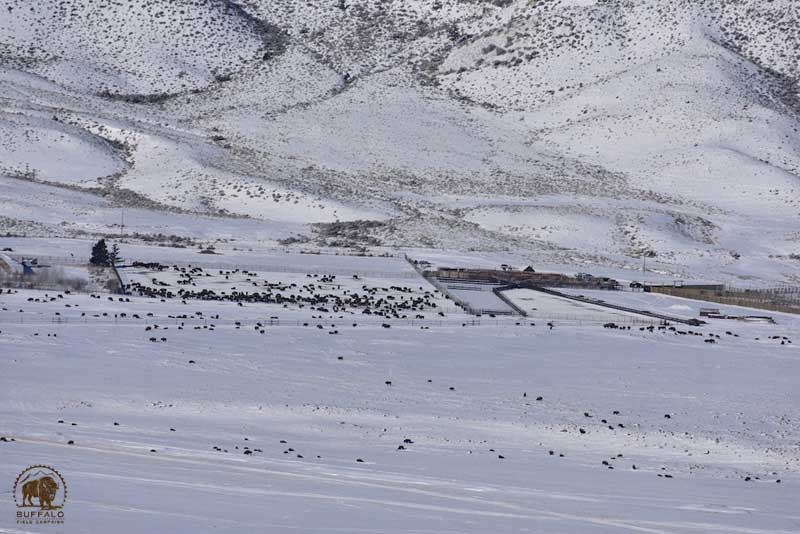
A bird’s-eye view of Yellowstone’s Stephens Creek buffalo trap. The massive closure is an attempt to keep the public from seeing what Yellowstone is doing. BFC photo by Stephany Seay.
Anticipating shipments to slaughter, the next morning we rise even earlier to get our sites on the trap before the trailers arrive. We are well ahead of schedule. Our presence, our vigilance is the only way for anyone to know what is taking place here, for anyone to know what is really happening to the buffalo. Once posted up, we send one patrol high into the hills for an even better birds-eye view. Even so, both lookouts rely on the powerful magnification of spotting scopes to see anything, and tiny-dot-anythings at that. With the naked eye, the trap and it’s happenings are hardly visible at all. The trap is so strategically located that Yellowstone’s shame and desire for secrecy are apparent. Just before dawn, multiple vehicles start arriving to the trap. The unmarked rigs of the wranglers, a few park service law enforcement officers, Yellowstone’s bison biologist, Rick Wallen, and others, get ready for another day of wild buffalo abuse. Then the stock trailers show up, flanked by law enforcement escorts. It takes less than an hour for them turn wild buffalo from sacred, free-born beings into “pounds on the hoof” headed for the slaughter house.
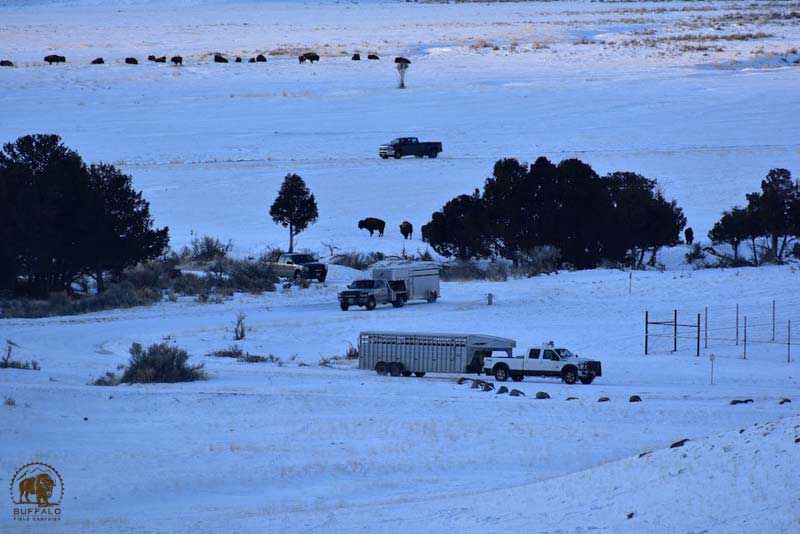
2018 03 01 03 003 Update3 Buffalo Field Campaign Stephany Seay 2018 800 Two stock trailers drive through Yellowstone, and groups of buffalo, taking buffalo who were captured at Yellowstone’s facility to slaughter on Wednesday morning. BFC photo by Stephany Seay.
The dominant culture — not even those who might care — can’t bear to look into the face of the reality of its actions. It views the human supreme; born out of a cold arrogance lusting for control, enabling the conversion of the living into the dead for profit. Forgetfulness, mindlessness – “with guns and laws and truth that lies” – help grease the gears of the machine; numbness is the key to conducting wildlife “management.” It is said that once you see, you cannot unsee. A self-inflicted blindness enables it —to see would break their hearts and force their souls wide open. So, with brutal efficiency, the government workers keep their blinders on, do their jobs, and hold fast to the agreed upon Interagency Bison Management Plan.
Approximately 450 wild buffalo have been captured in Yellowstone’s trap, and nearly 250 have been killed by hunters just across Yellowstone’s boundary. By Yellowstone and Montana’s own standards, the middle-end of their 600-900 kill quota — in place to appease Montana’s cattle interests — has already been met. After the last few weeks of extremely unsavory ‘hunting’ along Yellowstone’s north boundary, very few hunters have come to kill buffalo this week. Many have left here utterly disgusted, vowing never to participate in such a slaughter again.
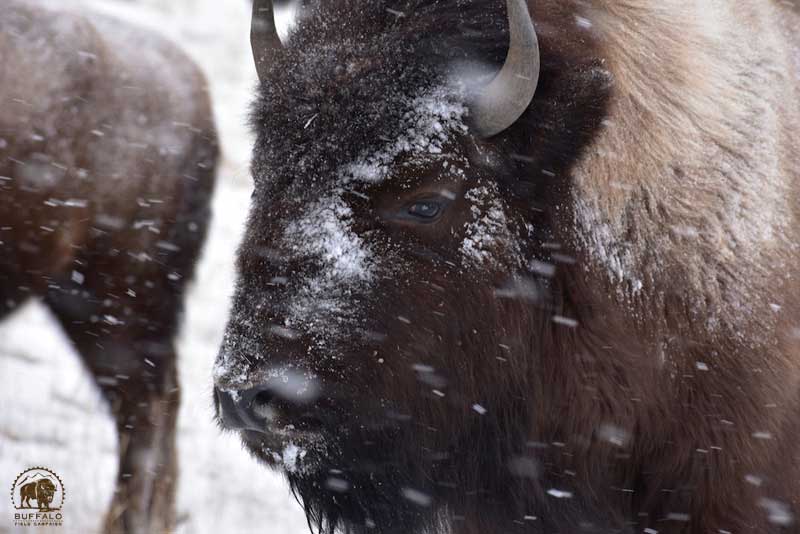
With their enormous, shaggy heads, buffalo face into a storm. We have much to learn from our relatives, the buffalo. BFC photo by Stephany Seay.
Before and after bearing witness to this insanity, we are reminded of the real reason we are here. Other buffalo, who were not in the trap, gave us the gift of remembering and connection, the honor of being in their presence and living in the moment. They help us remember who we are fighting for — and with — and why. The buffalo help us connect with their humbling ancient wisdom; a truth so incredibly sacred because of its gentle simplicity and rightness.
The blizzard came in quick and heavy, and the buffalo moved right along with it as they always do. With their heads into the storm, grazing and walking, sparing and goofing around, they look up at us for moments with the eyes of god, the faces of ghosts, awakening memories of ages past and future potentials. Still here. Still present. Still doing what they have always done since buffalo time began. Where they walk, ravens feast on the gut piles of their recently killed relatives, strewn across the landscape at Beattie Gulch, a beautiful place that has become synonymous with death. And, yet, the buffalo still come, still offer life, staying among the living. Obstacles be damned. These ancient beings have survived Ice Ages; now the question is: can they survive the U.S. government? In the joy of sharing time and place with the buffalo, in our pain and anger fueled by management plans, being in the company of friends both human and buffalo recognizing each other, committing to each other again; in our solidarity among our comrades we understand that all of these things come from love. Profound love. The buffalo and their wildness, their teachings of sorrow and joy, their obligation to the earth, and ours to them. These realities keep awake our spirits, reaffirm and strengthen our vow: yes, you will survive, and we will give ourselves to make sure of it; fighting for you, along side you.
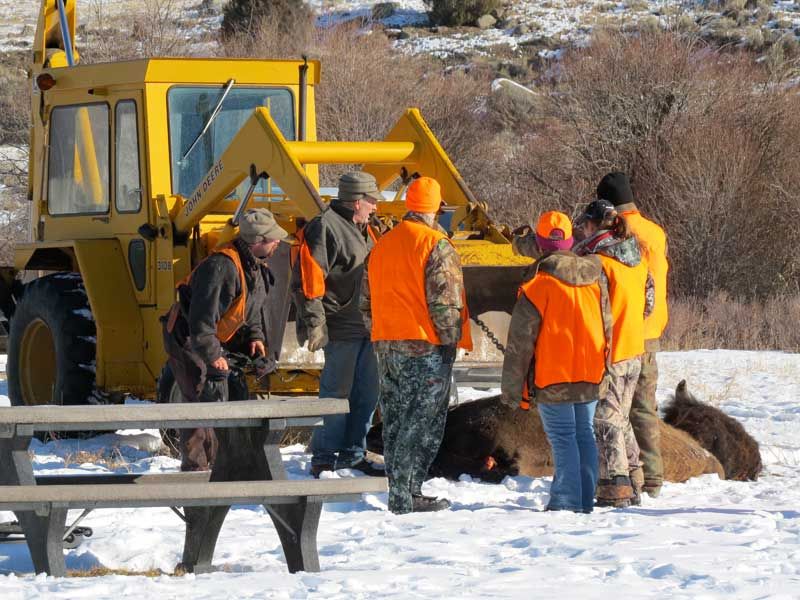
by Deep Green Resistance News Service | Feb 14, 2018 | Biodiversity & Habitat Destruction
Featured image by Buffalo Field Campaign
by Max Wilbert / Deep Green Resistance
Two days ago, three of last wild bison were shot and killed illegally in a no-shooting zone in a campground barely 100 yards from the boundary of Yellowstone National Park.
The next morning, I skied out of the woods with a patrol from Buffalo Field Campaign and found the buffalos’ butchered carcasses; ribcages, stomachs, patches of hide, and a few leftover chunks of flesh parting the slowly flowing water of the Madison River.
I’m not opposed to hunting. In fact, I’m a hunter myself and am looking forward to elk season. The problem is that the Central Herd of the Yellowstone buffalo number less than 700. Their numbers have plummeted in recent years. Park biologists say that the population decline is “unexplained,” but it seems pretty well explained to me: hazing, harassment, human manipulation, and overhunting are driving wild buffalo in Yellowstone to the brink.
I just learned a few minutes ago that the other major threat (besides unsustainable overhunting) to wild buffalo in the greater Yellowstone area is nearly ready to begin operation. Yellowstone National Park is opening their buffalo trap on the north side of the park in the Gardiner Basin. At this facility, your tax dollars and your public lands are put to work to trap and ship to slaughter hundreds of wild buffalo each year in an effort to maintain populations at an artificially low “minimum sustainable number.” All this is being done on behalf of Montana’s infamous livestock industry.
The total buffalo population is less than 4700, and the U.S. government and legally permitted overhunting is killing hundreds per year.
#
Here at Buffalo Field Campaign, everything revolves around the buffalo. Patrols leave every morning and afternoon to keep tabs on herds and hunting activity. Another group monitors the trap and firing-line style hunting at Gardiner. We gather each evening to discuss the day’s activity and share information on where the buffalo are, how many are located in which areas, which direction they are moving, what patrols to do the next day, and so on.
On bad days, we share information on how many were killed.
We bear witness to these atrocities and organize to stop them under a buffalo skull mounted on the wall and a shrine of artwork, poems, quilts, and other items dedicated to or inspired by the buffalo. As I write this, I can look up and see artwork from kids. “I heart buffalo – Tatanka roam free!” “Don’t kill the buffalo!” “I love buffalos.”
The headquarters of Buffalo Field Campaign is located in a 100-year-old cabin that was originally built for railroad workers. The irony that a building originally constructed by one of the prime instruments of western colonization is now being used to house a resistance movement isn’t lost on us.
But the walls are thick and the old stonework throws heat from the big wood stove nicely. This is a good place now. A 20-year spirit of resistance emanates from the patina on the lodgepole pine walls and the hearts of the people moving through the space. It’s practical, too. We’re close to the areas where hunting and hazing pressure is highest, and having a place to warm up, eat a delicious meal (fresh 20-inch trout and wild rice last night), and sleep soundly is important after a day out skiing in 5-degree temperatures.
#
Sitting around camp this afternoon after returning from patrol with a few friends, we talked about how the dominant culture is killing everything. Prairie Dogs are being poisoned en masse in Colorado (and elsewhere). Pinyon-Juniper forests are being bulldozed into oblivion. The oceans, the watery womb of all life on this planet, are dying.
Places like Buffalo Field Campaign provide a starting point for building effective resistance. Long-term, grassroots projects based on non-compromising defense and material support are essential. And organizations allow for enough resources to be gathered in one place to be more effective.
In an article titled, “Once, the Monsoon,” my friend Suprabha Seshan writes about her work in plant conservation in the Western Ghat mountains in India. She writes of the breathtaking beauty of her home, “where a small team of dedicated ecosystem gardeners, skilled in various aspects of horticulture, plant conservation and Western Ghat ecology, grow native plants of this mountain ecosystem, or biome, through techniques honed over four decades of experimentation and practice.
“The trails are full of jackfruit (Artocarpus heterophyllus) and smashed, partly-eaten remains of its relative, the ainili (Artocarpus hirsutus), which sports smaller orange fruits with a spiny skin enclosing lobes of sweet flesh and large seeds. Wild jamuns and mangoes, rose apples, guavas and sweet limes, and dozens of forest tree species are also fruiting. Bonnet macaques, Nilgiri langurs, Malabar grey hornbills and giant squirrels are gorging in the canopy. Someone reported seeing a troop of lion-tailed macaques with babies. It is feasting time for everybody in this valley: wild boar, humans and cattle included. Elephants come by at night, attracted from afar by the smell of overripe jackfruit—to them, a delicacy.”
Her team cultivates more than 2,000 species of highly endangered plants, “mostly from areas that have already been deforested.” She describes their work as a search-and-rescue mission, writing that “we refer to these plants as refugees, similar to human refugees suffering the depredations of war, displacement, climate change and general toxification of the environment.”
The monsoon that brings life-giving rain to the Western Ghat mountains is failing because of global warming. Rains are coming late or not at all. All the beings that are dependent on the monsoon, including humans, are at risk of total collapse because industrial civilization is destroying the Earth’s climate. The heroic work being done at the Gurukula Botanical Sanctuary could be undone by the collapse of the biosphere as a whole. Suprabha concludes her article by saying that we need to be asking where our loyalty lies: with “the machines or the monsoon?”
Here with the buffalo, the same questions are occurring to me. The heroic work of defending the buffalo is absolutely essential, and unless the death march of this culture is stopped, the buffalo are headed for the same extinction that faces us, too.
I want a world in which wild buffalo roam 60 million strong and in which the monsoon brings rivers of rain to the Western Ghat mountains. This will require working with organizations like the Buffalo Field Campaign and the Gurukula Botanical Sanctuary, and it will also require dismantling the larger systems that are killing the planet.
Without both approaches—fighting for the local, and dismantling the global—we, and the buffalo, and the monsoon, are doomed.
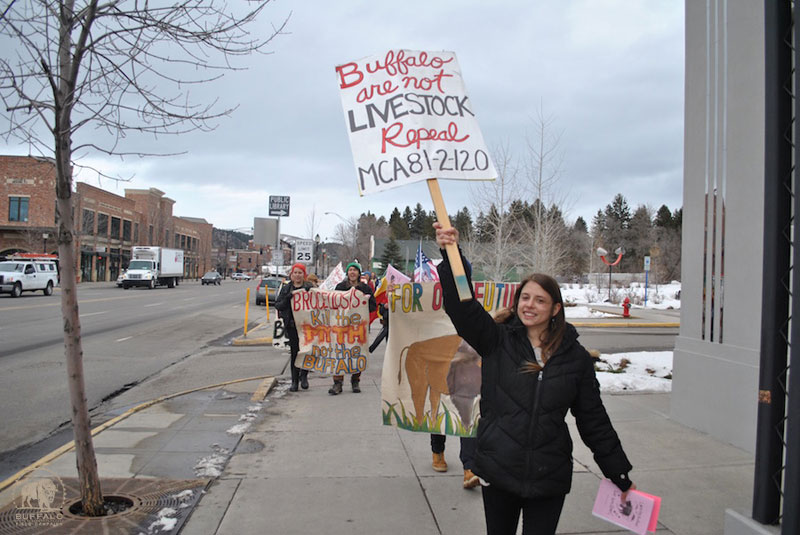
by Deep Green Resistance News Service | Feb 13, 2018 | Protests & Symbolic Acts
by Buffalo Field Campaign
Mark your calendars and plan to join Buffalo Field Campaign for some winter rallies for wild buffalo!
Yellowstone, Montana, and other bison managers have aims to kill upwards of 900 of the gentle giants this winter, all to appease Montana’s infamous livestock industry. The country’s last wild buffalo — a sacred and keystone species who is our National Mammal — are in dire straights and we must rally together to demand that they are protected and allowed to flourish, not be slaughtered to satisfy the whims of the cattle industry.
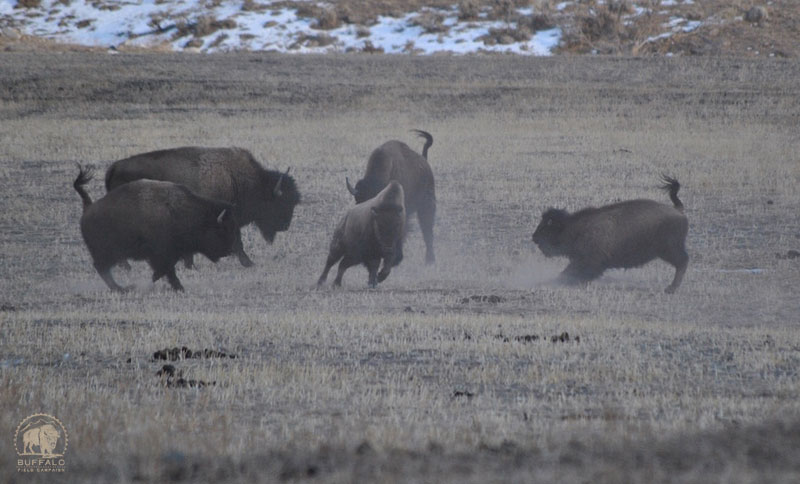
BFC Week of Action!
February 12 – 18, 2018
Join us for a series of gatherings, events, and rallies that we have planned for various towns near Yellowstone National Park. Dates, locations, and details are as follows:
Feb. 12, Monday, BFC Headquarters, West Yellowstone, MT
Kick off the week at camp with a meet-and-greet, orientation, and feast before we begin the week’s events.
Feb. 13, Tuesday, Gardiner, MT. First Annual Rosalie Little Thunder Memorial Walk
At 1:30 pm, gather at the Gallatin National Forest Gardiner Ranger District Office, 805 Scott St W, Gardiner, MT. We will begin our walk at 2:00 pm. We will walk through the town of Gardinger, past the Roosevelt Arch, and down Old Yellowstone Trail through Yellowstone National Park, The walk will end around 5:30, at the Beattie Gulch Trailhead, where we will share a meal and then hold a candlelight vigil in solidarity with wild buffalo and all of their advocates.
Feb. 14, Wednesday, Bozeman, MT. Rally Through Downtown
We will have an information table at the Bozeman Library, 626 E Main St, Bozeman, MT, from 11:00 a.m. – 4:00 p.m. We will gather banners, signs, and puppets, and march up and down Main Street throughout the day. Lunch and snacks will be provided.
Feb. 15, Thursday, BFC Headquarters. National Call-in Day and Day in the Field
A day of rest, direct action trainings, and field orientations for folks at camp. Everyone around the country and the globe will chime in and make Yellowstone’s and Montana’s phones ring off the hook as we hold our National Call-in Day. Targets and contact information will be forthcoming.
Feb. 16, Friday, Helena, MT. Rally at the State Capitol
Meet on the steps of the state capitol building, 1301 East Sixth Avenue, from 12:00 p.m. – 3:00 p.m. for a rally. We will have speakers from various Tribes, BFC, and other organizations to share their inspiration about wild buffalo. We anticipate drumming, singing, and story-telling. Possibly a visit to Governor Bullock’s office. Folks are also welcome to visit the office of the Montana Department of Livestock to share your feelings with them. A hot meal will be provided after the event. More details regarding speakers, etc., will be shared as available.
Feb. 17, Saturday, West Yellowstone, MT. Rally Through West Yellowstone
Meet at BFC Headquarters by 8:00 am for breakfast, or by 11:30 to carpool to town, or meet at Buffalo Spirit at 12:00, 14 N Canyon St, West Yellowstone, MT. From noon until 3:00 p.m., we’ll break out the banners, signs, drums, and puppets and march through the town of West Yellowstone, which is the most visited entrance to Yellowstone National Park.
Feb. 18, Sunday, BFC Headquarters. Gathering, Feasting, Trainings, and Story-Sharing
Enjoy a day in the field with the buffalo, learn from experienced activists, relish a delicious dinner, then share the stories and songs from your culture or your experiences, and learn from others. This close-down to our Week of Action is a bonding time that strengthens our solidarity as we move forward to defend the Earth from wherever we roam.
More information will be provided as we build these events. Please RSVP with our volunteer coordinators at volunteer@buffalofieldcampaign.org or call 406-646-0070. Bring friends, bring creative energy, bring your love for the wild!
by Deep Green Resistance News Service | Jan 13, 2018 | Biodiversity & Habitat Destruction
Editor’s note: On January 8, 2018, a federal judge dismissed US government’s criminal charges against Nevada rancher Cliven Bundy, two of his sons and another man linked to militia groups, over procedural errors made by the prosecution. This is a history of the Bundy grazing allotment.
by Center for Biological Diversity
• The Bundy family began grazing on federal public lands near Gold Butte, Nevada, in 1954 – lands located in the recently designated Gold Butte National Monument – some of the driest and most fragile desert in North America.
• In 1973 the Bundys were granted their first federal grazing permit. Given the aridity and fragility of the desert, the Bureau of Land Management (BLM) issued a permit for grazing in this ephemeral range, which is subject to environmental and other conditions. Ephemeral range in the southwest desert region does not consistently produce forage for grazing.
• In 1989 the desert tortoise was granted protection under the federal Endangered Species Act because of widespread destruction of its fragile desert habitat by livestock grazing, urbanization and other factors.
• In 1991, the U.S. and Fish and Wildlife Service (FWS) issued a draft Biological Opinion (BO) governing the management of desert tortoise habitat. The BLM developed a timetable to meet its requirements and shared the requirements and timetable with permittees, including Cliven Bundy, whose cattle grazed in tortoise habitat. The BLM requested and FWS then agreed to delay implementation of the BO until 1993.
• On February 26th, 1993, Cliven Bundy sent two “Administrative Notices of Intent” to the BLM asserting that the BLM has no legal jurisdiction over federal public lands, and stating his intent to graze cattle, “pursuant to my vested grazing rights.” Bundy stopped paying his grazing fees after February 28th of 1993.
• The BLM sent Bundy a notice that his request for a grazing application had not been received and requested that he re-submit within one week or BLM action would be taken.
• On July 13, 1993, BLM sent Bundy a Trespass Notice and Order to Remove which set a timeline for cattle removal given his non-payment of fees. Later BLM extended the timetable at Bundy’s request.
• On September 30, 1993, the Nevada State BLM Director requested injunctive relief—action from the court—to address Bundy’s unlawful cattle grazing.
• On January 24, 1994 BLM tried to deliver to Bundy a proposed decision to cancel his permit, request payment of trespass damages, and order the removal of trespass livestock. When BLM delivered the notice, Bundy’s son tore up the document. The torn document was recovered and used as evidence of illegal grazing by the BLM in court.
• On March 3, 1994, Cliven Bundy, given his refusal to recognize federal authority to own and administer federal lands, sent payment for his grazing permit to Clark County instead of the BLM. The county refused Bundy’s payment for lack of jurisdiction.
• In 1998, the U.S. Attorney filed suit requesting that the federal district court order Bundy to remove his cattle and pay outstanding grazing fees and fines totaling now more than $150,000.
• In October 1998, the BLM approved a new Resource Management Plan for the Las Vegas Field Office. The plan allowed for the closure of grazing allotments in critical tortoise habitats, including the Bunkerville allotment.
• On November 3, 1998, United States District Judge Johnnie Rawlinson permanently enjoined Bundy from grazing his livestock within the Bunkerville allotment. Rawlinson assessed fines against Bundy, affirmed federal authority over federal land, and wrote that “[t]he government has shown commendable restraint in allowing this trespass to continue for so long without impounding Bundy’s livestock.” Cite.
• Bundy refused to comply with the order. He filed an emergency motion for stay to try and halt the court ruling while he appealed the case to the Ninth Circuit Court.
• On May 14th, 1999, the Ninth Circuit Court denied Bundy’s appeal and upheld the district court decision ordering the removal of Bundy’s cattle from the Bunkerville allotment. Cite.
• On September 17th, 1999, after Bundy refused to comply with the court’s earlier orders, the Federal District Court again ordered Bundy to comply with the earlier permanent injunction and assessed additional fines.
• In December 1998, in order to mitigate harm to desert tortoise from urban sprawl, Clark County purchased the federal grazing permit to the Bunkerville Allotment for $375,000. The county retired the allotment to protect the desert tortoise. With the ongoing trespass cattle, Clark County inquired as to the rights of Cliven Bundy to be on the allotment. In a July, 2002 memo the BLM stated that the “Mr. Bundy has no right to occupy or graze livestock in the Bunkerville grazing allotment. Two court decisions, one in Federal District Court and another in the Circuit Court of Appeals,
fully supports our positions.”
• On April 2, 2008 the BLM sent Bundy a notice of cancellation, cancelling Bundy’s range improvement permit and a cooperative agreement. The notice called for the removal of his range improvements, such as gates and water infrastructure.

Cattle have been grazing in the vast Gold Butte area since an armed standoff between the government and self-styled militia in 2014.
Kirk Siegler/NPR
• On May 9, 2008 Cliven Bundy sent a document entitled “Constructive Notice” to local, county, state, and federal officials, including the BLM. It claimed that Bundy had rights to graze on the Bunkerville Allotment; it called on state and county officials to protect those rights from the federal government; and it responded to the BLM’s April 2 Notice of Cancellation by saying he has not ignored it, and that he will do whatever it takes to protect grazing rights.
• In 2011, BLM sent Bundy a cease-and-desist order and notice of intent to roundup his trespass cattle.
• In 2012, BLM aerial surveys estimated about 1000 trespass cattle remained.
• In April 2012, the BLM at the last moment canceled plans to roundup trespass cattle to ensure the safety of people involved in the roundup after Cliven Bundy made violent threats against BLM.
• On July 2013, U.S. District Court of Nevada again affirmed that Bundy has no legal rights to graze cattle. It ordered Bundy to remove his cattle from public lands within 45 days and authorized the U.S. government to seize and impound any remaining cattle thereafter. Cite.
• In October 2013, after an appeal by Bundy, the federal court again affirmed that Bundy had no legal right to graze cattle on federal public lands. The court ordered the removal of cattle within 45 days and ordered Bundy not to interfere with the round-up. Cite.
• In March 2014, the BLM issued a notice of intent to impound Bundy’s trespass cattle and closed the area to the public for the duration of the action.
• On April 5, 2014 the roundup began.
• On April 9, 2014 heavily armed militia from across the U.S. converged on the Bundy ranch to confront federal officials conducting the roundup.
• On April 12, about 300 cattle that had been rounded up and held in a corral were released by the BLM after the heavily armed militia confronted and aimed rifles at federal agents. The BLM canceled the roundup out of safety concerns for employees and the public.
• In April 2015, Bundy held a weekend barbecue and “Liberty Celebration” to mark the one-year anniversary of the standoff.
• In June, 2015, shots were fired near public land surveyors working in the Gold Butte area. BLM orders all employees to stay away from Gold Butte.
• On Feb 11, 2016, Cliven Bundy was arrested at the Portland, Oregon airport on his way to support his son’s paramilitary occupation of the Malheur National Wildlife Refuge in Oregon.
• As of February, 2017, Bundy’s trespass cattle continue to graze illegally on federal public lands near Gold Butte.












